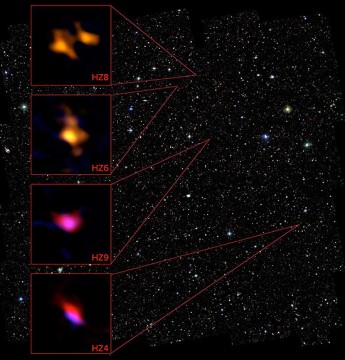New ALMA observations reveal low levels of dust in nine early galaxies, suggesting astronomers should revise some of their calculations.
Much like in the space beneath my couch, dust builds up in the universe over time. Dust comes from stars, either formed in the winds of old, swollen stars or when massive stars go supernova. Astronomers expected that dust would take a while — I’m talking on the order of a billion years or more — to substantially build up in the universe’s galaxies.

Credit: ALMA (NRAO / ESO / NAOJ) / P. Capak / B. Saxton (NRAO / AUI / NSF) / NASA / ESA Hubble
But back in March, Darach Watson (University of Copenhagen, Denmark) and colleagues reported that the galaxy A1689-zD1 was remarkably dusty, given that we’re seeing it as it was only 700 million years after the Big Bang (its redshift is 7.5). The result added to previous work that suggested early galaxies could potentially build up as much dust — compared with their masses — as galaxies today.
In my blog at the time, I noted that the study showed that the Atacama Large Millimeter/submillimeter Array (ALMA) could give us a window on dust and star formation in the early universe. Peter Capak (Caltech) and colleagues have now used ALMA, with other optical and infrared data, to do just that. The team looked at nine galaxies shining at us from about a billion years after the Big Bang (redshifts of 5 to 6). The astronomers detected dust emission from only four of the nine galaxies, but detected a form of ionized carbon known as [CII] in all nine.
As the authors explain in the June 25th Nature and in an NRAO press release, the presence of all this ionized carbon suggests a low level of dust. Carbon likes linking up with other elements to form molecules, so it doesn’t hang around by itself for long. But with few heavy elements to bond with, and with minimal dust around to protect the carbon atoms from the ionizing influence of ultraviolet radiation — which is pouring out from the young stars in these galaxies — the [CII] has stuck around and become fairly concentrated.
What the Dust Means
The implication is thus that these galaxies have similar amounts of dust to the Small Magellanic Cloud, a dwarf galaxy making a pass by the Milky Way. That’s unsurprising, says Veronique Buat (Astrophysics Laboratory of Marseille, France). Dwarf galaxies tend to be less “evolved” in terms of their heavy elements and thus more like the universe’s early stellar metropolises.
Astronomers usually assume a particular relationship between a galaxy’s ultraviolet and infrared emission, which (because infrared emission generally comes from dust warmed by starlight) indicates how dusty a galaxy is. The new result confirms that we cannot assume this relationship holds for galaxies in the early universe, because there’s less dust then. The team also says that, because astronomers estimate the rate of starbirth from this relationship, too, such estimates could be too high for individual, early galaxies. But the assumption probably has much less of an effect on our estimates of global (well, universal) starbirth across cosmic time, because most stars form in less luminous galaxies that we already assume have very little dust. And individual estimates that assume a galaxy has dust properties similar to the Small Magellanic Cloud, such as a 2013 study that found an early galaxy forming several hundred times the number of stars per year that the Milky Way does, are okay.
Interestingly, two of the team’s galaxies have similar amounts of dust to A1689-zD1, the lone dusty galaxy that raised eyebrows earlier this year. But A1689-zD1 existed 300 million years before these galaxies. What counts for a “moderate” amount of dust a billion years after the Big Bang is “challenging” only 700 million years after the Big Bang, Buat says. Perhaps in general dust buildup was slow, but some galaxies jumped the gun and got dusty fast.
Reference: P. L. Capak et al. “Galaxies at redshifts 5 to 6 with systematically low dust content and high [CII] emission.” Nature. June 25, 2015.
Like what you read? Subscribe to Sky & Telescope for more great articles on astronomy and skygazing!
 0
0









Comments
You must be logged in to post a comment.